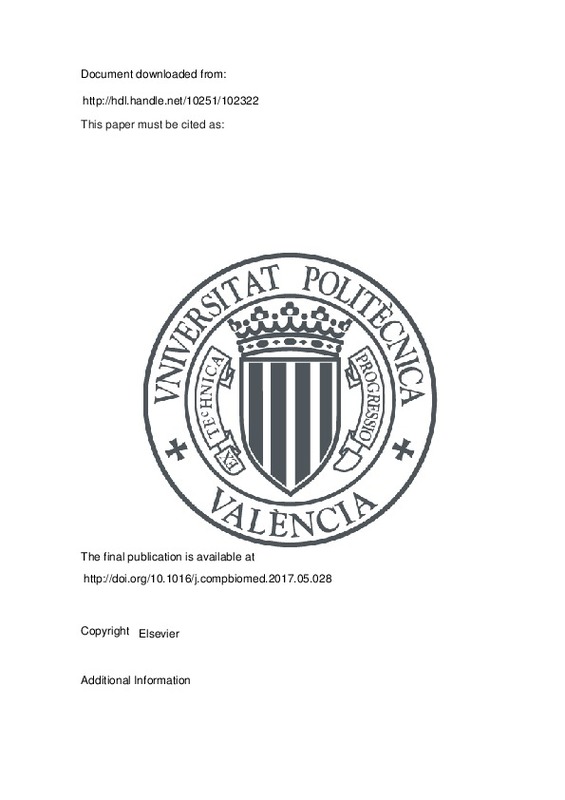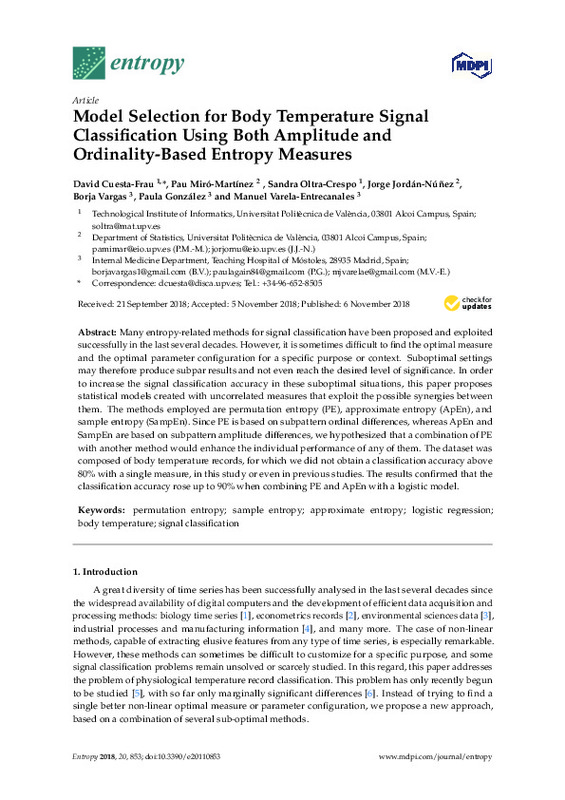JavaScript is disabled for your browser. Some features of this site may not work without it.
Buscar en RiuNet
Listar
Mi cuenta
Estadísticas
Ayuda RiuNet
Admin. UPV
Comparative study of approximate entropy and sample entropy robustness to spikes
Mostrar el registro sencillo del ítem
Ficheros en el ítem
| dc.contributor.author | Molina Picó, Antonio
|
es_ES |
| dc.contributor.author | Cuesta Frau, David
|
es_ES |
| dc.contributor.author | Riobo Aboy, Pedro Mateo
|
es_ES |
| dc.contributor.author | Crespo Sánchez, María Cristina
|
es_ES |
| dc.contributor.author | Miró Martínez, Pau
|
es_ES |
| dc.contributor.author | Oltra Crespo, Sandra
|
es_ES |
| dc.date.accessioned | 2015-07-24T11:38:11Z | |
| dc.date.available | 2015-07-24T11:38:11Z | |
| dc.date.issued | 2011-10 | |
| dc.identifier.issn | 0933-3657 | |
| dc.identifier.uri | http://hdl.handle.net/10251/53709 | |
| dc.description.abstract | Objective: There is an ongoing research effort devoted to characterize the signal regularity metrics approximate entropy (ApEn) and sample entropy (SampEn) in order to better interpret their results in the context of biomedical signal analysis. Along with this line, this paper addresses the influence of abnormal spikes (impulses) on ApEn and SampEn measurements. Methods: A set of test signals consisting of generic synthetic signals, simulated biomedical signals, and real RR records was created. These test signals were corrupted by randomly generated spikes. ApEn and SampEn were computed for all the signals under different spike probabilities and for 100 realizations. Results: The effect of the presence of spikes on ApEn and SampEn is different for test signals with narrowband line spectra and test signals that are better modeled as broadband random processes. In the first case, the presence of extrinsic spikes in the signal results in an ApEn and SampEn increase. In the second case, it results in an entropy decrease. For real RR records, the presence of spikes, often due to QRS detection errors, also results in an entropy decrease. Conclusions: Our findings demonstrate that both ApEn and SampEn are very sensitive to the presence of spikes. Abnormal spikes should be removed, if possible, from signals before computing ApEn or SampEn. Otherwise, the results can lead to misunderstandings or misclassification of the signal regularity. © 2011 Elsevier B.V. | es_ES |
| dc.description.sponsorship | This work has been supported by the Spanish Ministry of Science and Innovation, research projects TEC2008-05871 and TEC2009-14222. | en_EN |
| dc.language | Inglés | es_ES |
| dc.publisher | Elsevier | es_ES |
| dc.relation.ispartof | Artificial Intelligence in Medicine | es_ES |
| dc.rights | Reserva de todos los derechos | es_ES |
| dc.subject | Approximate entropy characterization | es_ES |
| dc.subject | RR interval record classification | es_ES |
| dc.subject | Sample entropy characterization | es_ES |
| dc.subject | Signal spikes | es_ES |
| dc.subject | Approximate entropy | es_ES |
| dc.subject | Biomedical signal | es_ES |
| dc.subject | Biomedical signal analysis | es_ES |
| dc.subject | Comparative studies | es_ES |
| dc.subject | Line spectra | es_ES |
| dc.subject | Misclassifications | es_ES |
| dc.subject | Narrow bands | es_ES |
| dc.subject | QRS detection | es_ES |
| dc.subject | Research efforts | es_ES |
| dc.subject | RR intervals | es_ES |
| dc.subject | Sample entropy | es_ES |
| dc.subject | Synthetic signals | es_ES |
| dc.subject | Test signal | es_ES |
| dc.subject | Bioelectric phenomena | es_ES |
| dc.subject | Random processes | es_ES |
| dc.subject | Entropy | es_ES |
| dc.subject | Article | es_ES |
| dc.subject | Controlled study | es_ES |
| dc.subject | Density | es_ES |
| dc.subject | Electrocardiogram | es_ES |
| dc.subject | Mathematical computing | es_ES |
| dc.subject | Power spectral density | es_ES |
| dc.subject | Priority journal | es_ES |
| dc.subject | QRS complex | es_ES |
| dc.subject | Sensitivity analysis | es_ES |
| dc.subject | Spike wave | es_ES |
| dc.subject | Stochastic model | es_ES |
| dc.subject | Algorithms | es_ES |
| dc.subject | Electrocardiography | es_ES |
| dc.subject | Humans | es_ES |
| dc.subject | Signal Processing, Computer-Assisted | es_ES |
| dc.subject | Stochastic Processes | es_ES |
| dc.subject.classification | ARQUITECTURA Y TECNOLOGIA DE COMPUTADORES | es_ES |
| dc.subject.classification | ESTADISTICA E INVESTIGACION OPERATIVA | es_ES |
| dc.subject.classification | MATEMATICA APLICADA | es_ES |
| dc.title | Comparative study of approximate entropy and sample entropy robustness to spikes | es_ES |
| dc.type | Artículo | es_ES |
| dc.identifier.doi | 10.1016/j.artmed.2011.06.007 | |
| dc.relation.projectID | info:eu-repo/grantAgreement/MICINN//TEC2008-05871/ES/INTERPRETACION Y CARACTERIZACION DE METODOS DE ANALISIS DE COMPLEJIDAD EN EL CONTEXTO DEL PROCESADO BIOMEDICO DE LA SEÑAL/ / | es_ES |
| dc.relation.projectID | info:eu-repo/grantAgreement/MICINN//TEC2009-14222/ES/Interpretacion Y Caracterizacion De Metodos De Analisis De Complejidad En El Contexto Del Procesado Biomedico De La Señal/ | es_ES |
| dc.relation.projectID | info:eu-repo/grantAgreement/Gobierno Vasco//EC2009-14/ES/Accesorios Para La Ampliación Del Espectrofotómetro Portátil De Infrarrojo Cercano "Labspec Pro Fr"/ | es_ES |
| dc.relation.projectID | info:eu-repo/grantAgreement/Gobierno Vasco//EC2009-1/ES/Sistema Multiperfilador Integrado De Alta Resolucion Para La Determinacion Espectrofluorimetrica De Materia Organica Disuelta, Hidrocarburos Y Nitrato En Medio Oceanico/ | es_ES |
| dc.rights.accessRights | Cerrado | es_ES |
| dc.contributor.affiliation | Universitat Politècnica de València. Departamento de Informática de Sistemas y Computadores - Departament d'Informàtica de Sistemes i Computadors | es_ES |
| dc.contributor.affiliation | Universitat Politècnica de València. Instituto Agroforestal Mediterráneo - Institut Agroforestal Mediterrani | es_ES |
| dc.contributor.affiliation | Universitat Politècnica de València. Departamento de Estadística e Investigación Operativa Aplicadas y Calidad - Departament d'Estadística i Investigació Operativa Aplicades i Qualitat | es_ES |
| dc.contributor.affiliation | Universitat Politècnica de València. Departamento de Matemática Aplicada - Departament de Matemàtica Aplicada | es_ES |
| dc.description.bibliographicCitation | Molina Picó, A.; Cuesta Frau, D.; Riobo Aboy, PM.; Crespo Sánchez, MC.; Miró Martínez, P.; Oltra Crespo, S. (2011). Comparative study of approximate entropy and sample entropy robustness to spikes. Artificial Intelligence in Medicine. 53(2):97-106. doi:10.1016/j.artmed.2011.06.007 | es_ES |
| dc.description.accrualMethod | S | es_ES |
| dc.relation.publisherversion | http://dx.doi.org/10.1016/j.artmed.2011.06.007 | es_ES |
| dc.description.upvformatpinicio | 97 | es_ES |
| dc.description.upvformatpfin | 106 | es_ES |
| dc.type.version | info:eu-repo/semantics/publishedVersion | es_ES |
| dc.description.volume | 53 | es_ES |
| dc.description.issue | 2 | es_ES |
| dc.relation.senia | 201560 | |
| dc.contributor.funder | Ministerio de Ciencia e Innovación | es_ES |






![[Cerrado]](/themes/UPV/images/candado.png)



